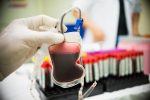Stem Cell Transplant Effective in Newborn With CEP: Case Study
Report shows importance of early diagnosis, treatment to avoid permanent effects

A stem cell transplant effectively eased the signs and symptoms of congenital erythropoietic porphyria (CEP) in a 3-month-old baby girl with severe disease, a case study reported.
The results underscore the importance of early diagnosis and treatment to avoid harmful and permanent CEP effects.
The case study, “Very early diagnosis and management of congenital erythropoietic porphyria,” was published in Clinical Pediatrics.
Porphyrias are a group of inherited conditions marked by disruptions in producing heme, an important molecule that helps transport oxygen throughout the body.
CEP is the rarest type of porphyria and is seen primarily in infants. It’s mainly caused by mutations in the UROS gene, which provides instructions for producing uroporphyrinogen III synthase (UROS), one of the enzymes required for making heme. Without this enzyme, porphyrins and other heme precursor molecules build up to toxic levels in different parts of the body.
A feature of CEP is severe light sensitivity, which can lead to skin blistering and infections. Early diagnosis is crucial to let supportive treatment begin before permanent changes can occur.
Treatment usually focuses on reducing exposure to sunlight and other possible triggers. A hematopoietic stem cell transplant (HSCT) is the only treatment that can restore functional UROS production and cure CEP, however. It involves collecting and transplanting hematopoietic stem cells, precursors that can give rise to all types of blood cells.
Canadian researchers described the case of a baby girl who was the youngest CEP patient to undergo a successful HSCT.
In the womb, the girl’s growth was delayed and she weighed just 2,240 grams at birth. Her liver and spleen were swollen and enlarged, and she had blood in her urine and blue-red skin blisters.
Lab tests showed a normal bone marrow production of red blood cells, low platelet count, and liver impairment. Infectious testing was negative.
Genetic testing revealed she had a mutation in the UROS gene (c.217T>C) — the most frequent mutation in CEP patients — that causes UROS activity levels to dip below 1% of normal. This mutation is usually associated with blood transfusion dependency from birth.
Further urine tests for porphyria showed high levels of uroporphyrinogen and coproporphyrinogen, which accumulate in CEP.
Initial treatments included sunblocks and blood transfusions. Due to the especially early onset of the disease and the poor estimated outcome, the baby girl underwent an HSCT at three months.
HSCT is currently reserved for people with severe CEP and “the decision must be balanced with the risks of complications related to bone marrow transplantation,” the researchers said. “For our patient, genetic testing before 72 [hours] of life allowed the initiation of supportive care and ultimately HSCT.”
The girl was given medications to prevent fungal and bacterial infections, and immunosuppressive agents to prevent graft-versus-host disease, a potentially life-threatening condition wherein transplanted cells see the recipient’s body as foreign and attack it.
About seven days after the transplant, she developed a blood clotting condition called thrombotic microangiopathy (TMA), a buildup of fluid in the area around the heart, and increased blood pressure. Researchers also observed blood and proteins in the urine, both signs of kidney dysfunction.
TMA was controlled by switching cyclosporine to prednisone, a corticosteroid, and Soliris (eculizumab), which is commonly used to treat atypical hemolytic uremic syndrome (aHUS), a form of TMA.
Two years after undergoing HSCT, the baby was faring well. She showed a significant decrease in urine porphyrin levels, suggesting “HSCT might be used early on in patients with a very severe [form] of CEP, before the occurrence of any irreversible complications,” the researchers wrote.
Physical exams showed red teeth discoloration (erythrodontia), a very rare symptom and one of the distinguishing signs of CEP. Blood tests also showed platelet and red blood cell counts had returned to normal, as did her heart, kidney, and liver function.
“Our case report presents the impact of a very early diagnosis and management on the outcome of CEP,” the researchers wrote.







